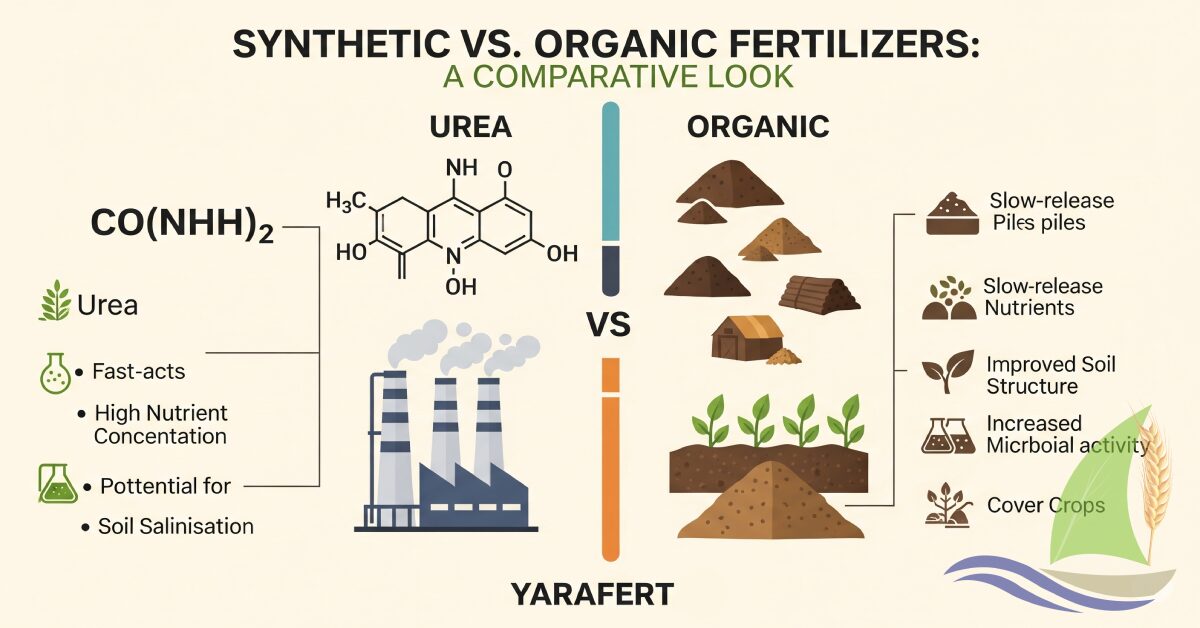Fertilization strategies continue to evolve as growers search for the perfect balance between yield, soil health, and sustainability. Among the most widely used inputs is urea fertilizer, valued for its high nitrogen concentration and cost-effectiveness. Yet, with rising interest in organic and regenerative practices, many farmers are asking: Where does urea fertilizer fit in the spectrum of synthetic and organic amendments?
This guide explores the science behind urea fertilizer, its comparison with natural soil enhancers, its role in sustainability, and its integration alongside organic-based products such as YaraFert Biofast, SULFOMIX, and CALCIMAG.
Defining urea fertilizer in synthetic terms
Urea fertilizer is a synthetic nitrogen source with the chemical formula CO(NH?)?. Containing 46% nitrogen, it is one of the most concentrated solid nitrogen fertilizers available. Manufactured by combining ammonia with carbon dioxide under high pressure, it is a product of modern industrial chemistry rather than natural decomposition.
Key attributes of urea fertilizer include:

- High nitrogen concentration: More efficient transport and application compared to bulky organic manures.
- Water solubility: Easily incorporated into fertigation systems and drip irrigation.
- Flexibility: Suitable for foliar sprays, soil broadcasting, or fertigation.
While urea fertilizer is purely synthetic, it can be combined with organic amendments such as Ugarit 10-0-5 + 70% Organic Matter (containing humic and fulvic acids) to improve soil biology and nutrient retention.
Urea fertilizer compared with natural amendments
Organic amendments like compost, manure, or seaweed extracts release nutrients slowly while improving soil organic matter. By contrast, urea fertilizer delivers nitrogen rapidly, providing an immediate boost during critical growth phases.
The comparison can be summarized as follows:
| Property | Urea Fertilizer | Organic Amendments |
|---|---|---|
| Nitrogen concentration | 46% N | 1–5% N (varies) |
| Release speed | Fast (hydrolyzes quickly into ammonium, then nitrate) | Slow, microbial-mediated |
| Soil impact | May acidify soil over time | Enhances soil structure & microbial activity |
| Application form | Granular, liquid, foliar spray | Solid (compost/manure) or liquid extracts |
| Cost per nutrient unit | Low | Higher |

A balanced system often integrates both. For example, Biofast (12-12-12 NPK with humic and fulvic acids) combines synthetic nutrients with organic compounds, bridging the gap between fast-acting nitrogen and soil-building organics.
Urea fertilizer’s role in sustainable farming

Critics often view urea fertilizer as incompatible with sustainability. However, when applied correctly, it can complement sustainable practices rather than oppose them.
Strategies for using urea fertilizer sustainably include:

- Precision fertigation: Delivering nitrogen directly to the root zone through drip irrigation reduces leaching losses.
- Blended nutrition: Pairing urea with balanced products like SULPHOMIN (45% N + 15% SO? + 25% organic matter) improves nutrient uptake efficiency.
- Soil health integration: Mixing with organic matter (e.g., Ugarit 10-0-5) minimizes volatilization and boosts microbial activity.
- Tailored timing: Splitting applications throughout the crop cycle reduces environmental risks.

When integrated thoughtfully, urea fertilizer becomes a tool for efficient nutrient management in climate-smart agriculture systems.
Nutrient efficiency of urea fertilizer vs. organic types
Nitrogen efficiency is one of the biggest deciding factors for growers choosing between urea fertilizer and organic sources. While organics improve long-term soil fertility, they often cannot match the immediate nutrient efficiency of urea.
Here’s how nutrient efficiency plays out:
- Urea fertilizer:
- Hydrolyzes into ammonium carbonate and then nitrate, making nitrogen quickly available.
- Works best when incorporated into the soil to reduce ammonia volatilization.
- Provides strong vegetative growth during early stages.
- Organic fertilizers:
- Require microbial decomposition before nitrogen is released.
- Provide secondary benefits like humus formation and trace elements.
- Support long-term nutrient cycling rather than immediate boosts.
To maximize nutrient efficiency, many farmers adopt integrated nutrition programs. For example:
- Use Ugarit 40-10-10 + TE during early vegetative stages for nitrogen and balanced P-K.
- Follow with Ugarit 10-10-40 + TE during fruiting for stronger potassium support.
- Supplement with CALCIMAG for calcium-sensitive crops like peppers and tomatoes.
This blended approach ensures both rapid availability from urea fertilizer and sustained soil fertility from organic elements.



Pros and cons of urea fertilizer in organic systems

Although pure urea fertilizer is not approved under most organic certifications, it can still play a role in transitional or integrated systems. Understanding its strengths and limitations helps farmers make informed choices.
Advantages of urea fertilizer:
- High nitrogen content reduces transportation and storage costs.
- Quick-release properties provide immediate crop response.
- Easily incorporated into irrigation systems for efficient delivery.
Disadvantages of urea fertilizer:
- Risk of nitrogen losses through volatilization if not managed correctly.
- Can contribute to soil acidification with long-term overuse.
- Lacks micronutrients and soil-building components found in organic fertilizers.

This is where complementary products like SULFOMIX (rich in Fe, Zn, Mn, Cu, B, and S) or Ugarit Beet (trace elements tailored for root crops) become critical. By supplementing urea fertilizer with micronutrient-rich products, growers can achieve a balance between immediate yield gains and long-term soil fertility.

Conclusion: Positioning urea fertilizer in modern farming
Urea fertilizer is undeniably one of the most efficient and cost-effective nitrogen sources in agriculture. While it is synthetic in nature, its role in farming systems does not have to conflict with sustainability goals. By integrating it with organic matter, micronutrient suspensions, and advanced blends like Biofast or SULPHOMIN, farmers can achieve both high productivity and improved soil health.
The key lies in balance: leveraging the rapid nutrient release of urea fertilizer while relying on organic and mineral-based products to support long-term fertility.
? Ready to optimize your nutrition program? Explore our full portfolio of YaraFert solutions, contact our agronomy team for tailored recommendations, and discover how integrated strategies with urea fertilizer can unlock higher yields and healthier soils.

